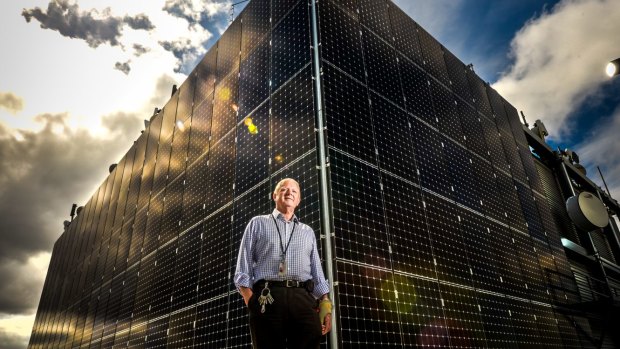This was published 1 year ago
Why our city office towers are turning green
Melbourne’s office tower owners have identified climate change as a key commercial property investment risk, with strong sustainability credentials and landlord willingness to agree to an electrification pathway for buildings a “must have” requirement for new tenants.
This has the potential to have a profound effect on property values both positively for those assets that can meet these requirements, and negatively for those that don’t.

101 Collins street has the largest commercial solar panel system in Australia. Bill Burgess is the engineers service manager at the building.Credit: Justin McManus
Proposed federal government legislation would require property investors, occupiers and building managers to report emissions in their annual reports, potentially starting in the 2024-25 financial year with the biggest companies and largest emitters.
The new regime has seen a tenant flight to new, quality, energy-efficient buildings to help achieve their climate goals. However, many prime office towers are still well short of tenant requirements, and would need major upgrades over the next few years if they are to remain competitive in the rental market.
Georgia Warren-Myers, former ESG, sustainability and climate risk expert at the University of Melbourne, says building owners are being forced to step up to improve their carbon credentials and cut investment risk.
“Net zero carbon ready buildings in Melbourne are rare, and there are only a handful of projects in the pipeline,” she says. “We are going to see a massive imbalance of supply and demand, which will have a direct impact of occupancy rates and rental prices.”
Warren-Myers, now JLL’s Asia pacific head of ESG risk advisory, says an escalation of extreme weather events, including more bushfires at a greater intensity, and extended heatwaves, are making building owners sit up and take notice. “They are becoming aware of the serious impact that these events – now and into the future – may have on their [investment] portfolios,” she says.
Many older office towers have fossil-fuel powered heating and their cooling systems are outdated. Their low energy-efficient ratings are likely to see them continue to lose energy-efficient hungry tenants if they don’t act.
The retrofitting of 101 Collins Street, which has the largest commercial solar panel system in Australia, and 500 Bourke Street, would make them among the first buildings in Melbourne to achieve full net zero carbon ready status by early next year.
However, there are still high-quality office towers being built that don’t meet premium carbon objectives, and their owners are taking advice on how they can make the transition to meet the targets.
“Those properties generally have excellent 5-6 star NABERS energy efficiency ratings, but typically still have some form of gas heating fossil fuels burnt on site, so still aren’t able to meet the net zero targets,” Warren-Myers says. “What we will see over the next few years is a focus on the electrification of much of our office stock.”
Secondary commercial property stock – under siege by high vacancy rates – could also differentiate themselves from the underperforming pack by upgrading their energy credentials. This could include moving to electrification and battery backed generators, together with renewables power, Warren-Myers says. “Improving their NABERS ratings can result in a major jump in the rent they command,” she says.
“By going green, secondary CBD buildings built from the 1970s-1990s can attain a rental premium of 10-30 per cent – if they can achieve a 5½ star-plus rating,” she says. The premium can be even greater for older buildings.
JLL’s senior director, strategic research Annabel McFarlane says building owners are more aware of their key tenants’ net zero emission commitments, including governments, corporates and major banks, who are making it clear that new leases would demand the highest possible sustainability ratings, plus pathways for the buildings to be net zero carbon ready.
“This influential anchor tenant cohort, which often underpins the feasibility of new buildings, have started to drive change around sustainability right across the office market,” she says.
“Strong sustainability credentials and landlord willingness to agree to electrification have become ‘must have’ requirements. This will have a profound effect on values both positively for those assets that can meet these requirements and negatively for those that don’t,” McFarlane says.
The Business Briefing newsletter delivers major stories, exclusive coverage and expert opinion. Sign up to get it every weekday morning.